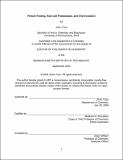Protein Folding, Host Cell Proteostasis, and Viral Evolution
Author(s)
Yoon, Jimin
DownloadThesis PDF (12.15Mb)
Advisor
Shoulders, Matthew D.
Terms of use
Metadata
Show full item recordAbstract
Pandemics and epidemics caused by pathological RNA viruses, such as the 1918 influenza pandemic, the global AIDS epidemic, and the recent coronavirus pandemic, impose a severe burden on global health and the economy. A major challenge associated with developing effective antiviral strategies is the exceptionally high mutation rate of RNA viruses, which endows them with a remarkable capacity to adapt to selection pressures such as antibodies or antiviral drugs. Hence, it is critical to understand the molecular-level factors that can constrain and potentiate viral evolution. While mutations benefit viruses by generating the diversity required for evolution, they also threaten viral viability because the majority of non-conservative amino acid substitutions cause protein folding defect. Mutations that result in substantial protein folding defects cannot be tolerated, regardless of how adaptively beneficial the resultant protein variant otherwise would be. Importantly, in cells, protein folding is assisted by intricate networks of chaperones and quality control factors, termed proteostasis networks. When a substitution on a protein impedes its proper folding, proteostasis network components can triage the defective protein variant to chaperones for folding assistance, or to quality control factors for timely degradation. Interestingly, virtually all RNA viruses rely on their host’s proteostasis network components for viral protein folding. It follows that the host’s proteostasis network could play a prominent role in defining the sequence space accessible to an evolving viral protein. In this thesis, I address how host proteostasis networks shape viral protein evolution. First, I describe how the composition of the host cell’s proteostasis machineries chapes the accessible sequence space of human immunodeficiency virus envelope protein. Second, I focus on an important immune-escape variant of influenza nucleoprotein whose fitness depends on host chaperones, and reveal the underlying molecular mechanism of the chaperon dependence. Finally, I demonstrate how chaperone machineries can determine the host range of viruses, and provide potential pathways viruses can evolve to overcome this selection pressure. Overall, elucidating how protein folding and host cell proteostasis affect viral protein evolution would substantially improve our ability to accurately predict RNA virus evolution and host-switching, and may enable design of host-targeted therapeutics that reduce the adaptability of RNA viruses.
Date issued
2024-09Department
Massachusetts Institute of Technology. Department of ChemistryPublisher
Massachusetts Institute of Technology